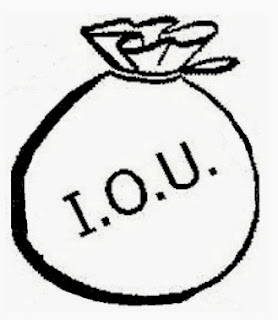In
Part 2, I discussed the illegal activities of the Dutch bankers who came up
with the idea of creating money out of thin air. Today, this is called “Fractional Reserve Banking” and it is
not only legal – it is the foundation of
our banking system. It is also one of the best kept unhidden secrets in the
world. I bet you will probably be surprised to hear that most bankers don’t
know anything about it either.
Here
is how I found out about it. Back in the “old
days” I was a banker and graduated from the Graduate School of Banking at LSU
(back then it was the School of Banking of the South at LSU). I remember the
first class we had about the Federal Reserve. The lecturer worked for the
Federal Reserve and everyone in the class was an officer in a bank. He began the
lecture that day by saying something like – “How would you like to learn how to create
money out of thin air?” Of course, we all shook our heads “yes.” He looked at
us for a few minutes without saying anything and then smiled and said – “You
have been doing it for years!”
The amazing thing about this secret is
that anyone can find out about it. A great source is the Federal Reserve
itself. It published a booklet called Modern Money Mechanics and you can download
a pdf version for free at -- https://ia600202.us.archive.org/3/items/ModernMoneyMechanics/MMM.pdf. When I use quotes
from it, I am referring to the “PDF Page Number.”
Let’s
begin with a quote from the booklet:
In the absence of legal reserve
requirements, banks can build up deposits by increasing loans and investments
so long as they keep enough currency on hand to redeem whatever amounts the
holders of deposits want to convert into currency. This unique attribute of the
banking business was discovered many centuries ago.
It started with goldsmiths. As early
bankers, they initially provided safekeeping services, making a profit from
vault storage fees for gold and coins deposited with them. People would redeem
their "deposit receipts" whenever they needed gold or coins to
purchase something, and physically take the gold or coins to the seller who, in
turn, would deposit them for safekeeping, often with the same banker. Everyone
soon found that it was a lot easier simply to use the deposit receipts directly
as a means of payment. These receipts, which became known as notes, were
acceptable as money since whoever held them could go to the banker and exchange
them for metallic money.
Then, bankers discovered that they could
make loans merely by giving their promises to pay, or bank notes, to borrowers.
In this way, banks began to create money. More notes could be issued than the
gold and coin on hand because only a portion of the notes outstanding would be
presented for payment at any one time. Enough metallic money had to be kept on
hand, of course, to redeem whatever volume of notes was presented for payment.
(Modern Money Mechanics p. 3).
The only things this version left out is
that the people depositing the gold and silver didn’t know what the goldsmith-bankers
were doing with their money -- and it was illegal.
What is fractional reserve banking.
Below is the definition:
A banking system in which only a fraction of bank deposits are
backed by actual cash-on-hand and are available for withdrawal.[i]
This is the definition of reserve:
Currency held in bank vaults may be counted as legal reserves as
well as deposits (reserve balances) at the Federal Reserve Banks.
(Modern
Money Mechanics p. 4)
Now let’s see how fractional
reserve banking works using a reserve
requirement of 10%. This means that the bank must keep 10% of every deposit
in cash in its vault or on deposit with a Federal Reserve Bank. This example
begins with a man named Adam who has $1,000.00 and deposits it in a bank.
The
bank takes Adam’s deposit of $1,000 and places $100 in reserve and loans Bill $900.
Adam’s bank account shows that he has $1,000 in the bank and Bill’s account
shows he has $900 in the bank. The bank only has $100 in cash, thus it created
$900 of Bank Credit Money out of
thin air. The US Treasury Department and the Federal Reserve were not involved.
No Federal Reserve Notes were created. The new $900 Bank Credit Money was
created by making an entry in a set of books.
Now, using the above
example, you will be able to follow Bill’s $900. Think about the mechanics of
each new transaction.
If
we looked at the bank’s books at this point we would see this:
Adam’s
$1,000.00 deposit has been used to create $5,859.00 of new Bank Credit Money
and the bank is now being paid interest on it.
Do
you owe the bankers any money? How much does debt influence your life? How much
influence and power does it have in the lives of its borrowers? How much real
property can a lender take from borrowers if they can’t pay and thus turn money
made out of thin air into real property?
There
is much more involved here than simply as business transaction. The power to do
this creates an elite class of people who affect – our political system, our justice system, our economic system, our
educational system, our military, our relationships with one another – just
to name a few!
How
much money can bankers create out of thin air?
We will discuss that in the next part of this series – Part 4.
PS:
Adam’s $1,000 will ultimately create $8,906.00 (see the example in Modern Money Mechanics, pages 6-11).
























